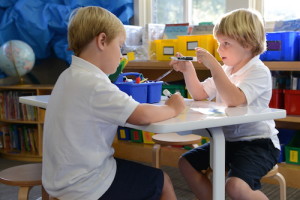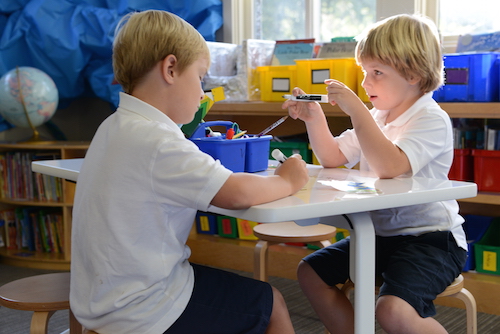A few weeks ago, I was outside the art studio and a rush of eighth graders ran by. They were in a hurry because it was recess and they wanted to finish a petition. In it, they were demanding the “re-messification” of the art studio. They told me that it had become too organized, too adult, and needed to be returned to its former state. Across the Hillbrook campus this year, the buzz has been building; classrooms are changing and everyone has something to say about it.
Taking a look around campus, you may notice many of these changes. Over a dozen teachers last May nominated themselves to kick-off our experiments with the physical classroom. They agreed to spend time substantially altering their space, to asking questions about how the changes affected teaching and learning, and to sharing their stories. The changes included both physical redesigns, and a re-thinking about students’ role in that design. We asked, “how can we include students in the setup of the classroom, and in real decisions about its use? How can we offer students in the same classroom more choices about how they want to work?”
 Hillbrook is not alone in re-designing spaces. Visitors to campus tell us about “21st Century Classrooms,” “Innovation Labs,” or multi-grade classroom areas with no walls dividing them. And they come to visit us because we are re-designing differently: leading with questions, and following up with research and reflection. Rather than having architects determine the designs, teachers at Hillbrook planned their own changes, starting with the question “what do I want learners to look like in my classroom?” And because we have altered each classroom in a different way, and not all the rooms at once, we are in a unique position to observe differences, and to ask testable questions about the effects of our changes.
Hillbrook is not alone in re-designing spaces. Visitors to campus tell us about “21st Century Classrooms,” “Innovation Labs,” or multi-grade classroom areas with no walls dividing them. And they come to visit us because we are re-designing differently: leading with questions, and following up with research and reflection. Rather than having architects determine the designs, teachers at Hillbrook planned their own changes, starting with the question “what do I want learners to look like in my classroom?” And because we have altered each classroom in a different way, and not all the rooms at once, we are in a unique position to observe differences, and to ask testable questions about the effects of our changes.
Take the arrival of whiteboard tables to some lower school rooms, for example. When replacing the individual desks, we had a lot of questions about how students would respond. How would their sense of belonging and place be altered when we took away “their” desk? Now that the whiteboard tables are in, we are noticing they create a different feel in the classroom. We notice that students (and teachers) feel more free to pull up a seat at a table than they did to join someone’s individual desk. We notice that we feel more comfortable adding to someone else’s writing surface, when it is erase-able, large, and not seemingly owned by an individual the way a paper is. We think we are seeing people apt to write more on whiteboards during brainstorming tasks, or to take more risks working out math practice problems. And we intend to find out.
Other teachers are focusing on physical movement. They have added new types of seating that include bean bags, chairs with wiggly seats, rocking stools, and sofa benches. One group of teachers observed that their wooden stools are being broken by students who are trying to use them as rocking stools. Do the rocking stools help students focus? Can we see a difference in productivity or engagement when students are able to meet their needs for movement while also doing classwork? Others are curious whether student choice of seating will improve their experience taking tests. Can you take a quiz productively in a bean bag? And does it lower your stress level to do so? We intend to find out.
We know that environment is not neutral. Every space invites and affords certain behaviors and types of thinking. When we as adults walk into a meeting with row seating, or a giant u-shaped table, or little circles of chairs, we understand a different kind of participation will be asked of us. And we intuit the range of tolerance for behaviors like snacking, whispering to our neighbor, or standing to stretch our calves. What do our classrooms say to our students when they walk in? What are we inviting them to think about or to do by the arrangement of our furniture, and the choices they have about how they use it?
At a recent Faculty Meeting, Alfie Kohn asked us what it would be like to move our school’s “center of gravity” away from the teachers and parents and towards students. How can we rethink what we ask students to do and not do, and what choices we give them, starting with what they want? How are we already doing this well and where could we benefit from taking a second look?
Last weekend at Open House I was at the table in the gym that advertised “Reimagining Classrooms.” In front of it were a desk chair, and a rocking stool. A visiting child approached, jumped on the rocking stool and laughingly declared, “Whoa, this is way too crazy a chair.” His mother and I chatted while he checked the limits of its sway–how far he could tip without falling, and whether when he sat at a table his arms on the surface braced his motion. The stool invited him to take a risk, and to share what he thought. And it turned out what he thought changed quickly with experiencing it. After a minute or two, having found his balance, he grinningly remarked, “I think I’m used to it now”. I hope we can continue to uncover similar surprises.
